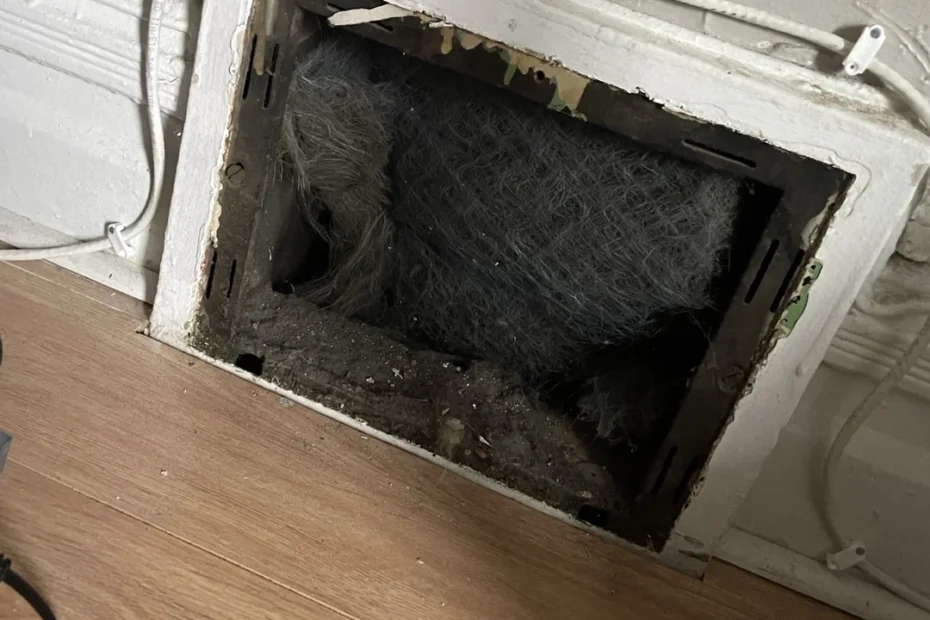A questioner said:
What is this stuff in the vents of my ~100 year old house?

It’s seems like hair but it’s more synthetic. I’m not sure if it’s some kind of sound dampening thing or filter but it seems really old either way. This is a roughly 100 year old house in downtown Ottawa, ON, Canada
Some of the answers:
- Horse hair air filter* could also be hog hair
- That’s a type of air filter material called “hogs hair”. It’s common, not dangerous, and has largely been replaced by cardboard-framed plastic filament filters.
- I have vents like this in the house I bought a while back. We had it tested, and it was asbestos, so we had the owner pay for removal prior to closing.
That said, asbestos usually isn’t harmful as long as it is not disturbed. We had it removed in our place because we planned to remodel and having it done in advance made it easier and cheaper for us int erms of lining up an HVAC contractor
- Horse-hair/hog hair filter: common in old homes. Get it out and replace with a modern filter.
- It looks like filter media but I’m not positive
- That looks nasty, but I would hire a HVAC pro instead of exploring it. If it’s not asbestos it should probably be cleaned.
- Not completely sure, but that could very well be asbestos. In that case it should not be touched at all and be removed/handled by professionals only
- It looks like fibre-glass air filter material. Seriously, if someone stuffed your air vents with asbestos, not wearing gloves would be the least of your worries…probably a little late to be worrying about a mask, at this point, too.
- That has not been in there for 100 years…it is not part of the original system. Fibre-glass designed to go in furnace filters is not brittle and subject to breaking into tiny pieces. If it was prone to becoming air-borne they wouldn’t use in air flow applications.
What do you think? Let us know in the comment!
As the custodian of a century-old house, one becomes intimately acquainted with its quirks and idiosyncrasies. Among the myriad mysteries that unfold within its time-worn walls, perhaps none are as confounding as the enigmatic substances lurking within its ventilation system. For homeowners who peer into the depths of their vents, curiosity often gives rise to the question: What is this stuff, and how did it find its way into the recesses of my aging abode?
Venturing into the bowels of a century-old house’s ventilation system can be a journey into the unknown, fraught with surprises and revelations. Within the labyrinthine network of ducts and conduits, a variety of substances may accumulate over time, bearing witness to the passage of decades and the activities of past inhabitants.
One of the most common discoveries within the vents of a century-old house is dust and debris—accumulations of particles that settle and accumulate over the years, propelled by the forces of air circulation and gravity. This dusty residue, composed of a myriad of microscopic particles, can harbor allergens, pollutants, and even traces of historical artifacts, providing a window into the past.
In addition to dust, vents in old houses may harbor other, more peculiar substances, ranging from cobwebs and insect carcasses to remnants of construction materials and household detritus. These unexpected findings offer glimpses into the house’s history, revealing traces of previous renovations, repairs, and inhabitants.
Furthermore, the contents of vents in a century-old house may vary depending on factors such as geographic location, climate, and architectural design. In regions prone to high humidity or dampness, vents may accumulate moisture and mold, posing potential health risks to occupants. Likewise, houses located in urban areas may contain higher levels of air pollution, leading to the accumulation of soot, smog, and other airborne contaminants within the ventilation system.
Moreover, the materials used in the construction of century-old houses may contribute to the composition of substances found within their vents. For example, houses built before the mid-20th century may contain asbestos insulation, a hazardous material that poses health risks when disturbed or degraded. Similarly, lead-based paint, common in older homes, may flake and deteriorate over time, releasing toxic particles into the air.
Despite the potential hazards and inconveniences posed by the contents of vents in a century-old house, exploring their mysteries can offer valuable insights into the house’s history and heritage. By examining the substances within their vents, homeowners can gain a deeper appreciation for the resilience and endurance of their aging abode, as well as the legacy of those who came before.
In the end, the stuff in the vents of a century-old house serves as a tangible reminder of the passage of time and the ever-changing nature of our built environment. While its origins and composition may remain shrouded in mystery, its presence underscores the interconnectedness of past, present, and future, linking generations of occupants in a shared journey through the annals of history.
